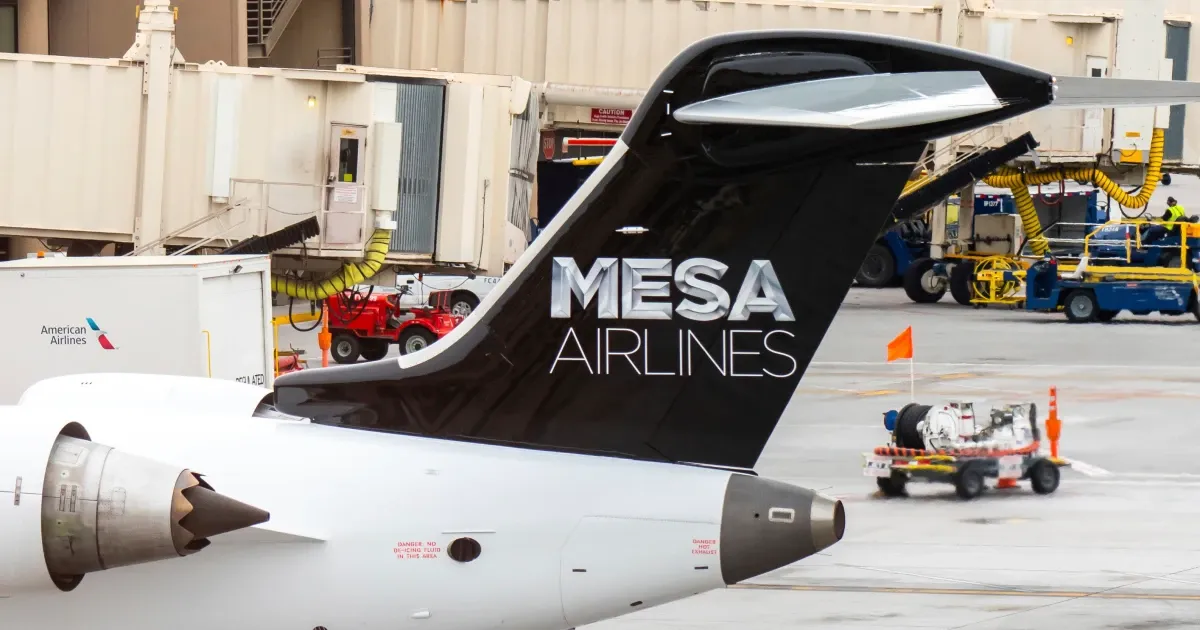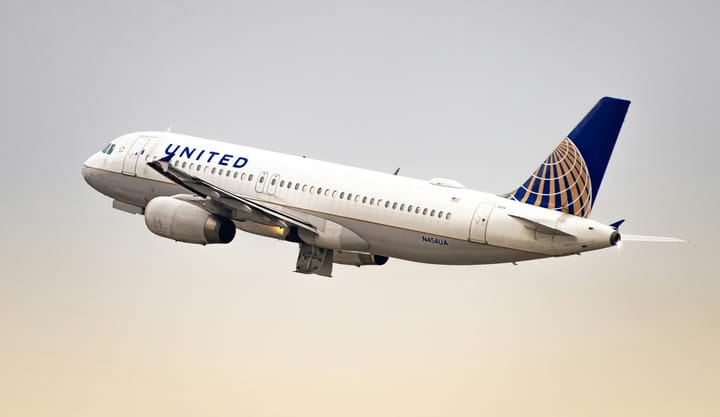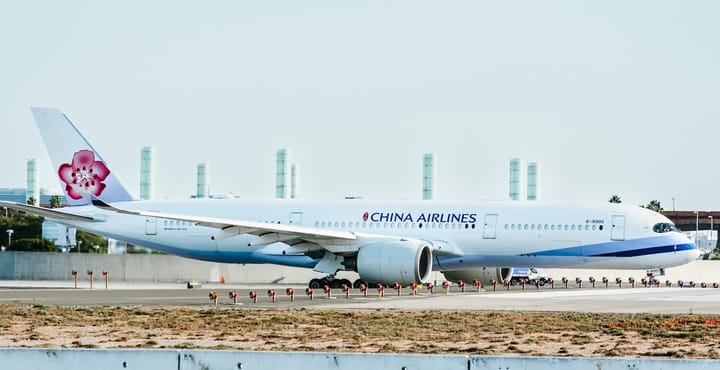Analysis of Mesa Airlines’ performance under capacity purchase agreements, highlighting regional flight metrics, ASM, RPM, load factor, and financials to assess operational efficiency and its role as a key regional partner to major U.S. carriers.
1. Total Passengers Carried
Mesa Airlines is a regional carrier connecting 67 cities across 34 U.S. states (plus routes to Mexico and Cuba) under its major airline partnerships. It operates all flights as United Express (and until early 2023, American Eagle and DHL Express) under capacity-purchase agreements. In FY2024 Mesa reported about 5.98 million passengers carried, down from 6.31 million in FY2023. This volume reflects Mesa’s scale in feeding major hubs; it carried millions of travelers despite its focus on smaller markets. For context, Mesa’s fleet (67 jets as of late 2024) averaged roughly 265 departures per day, underpinning these passenger totals.
Mesa’s passenger counts have varied with industry cycles and contract changes. After a pandemic-era rebound (~10 million passengers in FY2021), Mesa saw a 21.5% decline to 7.8 million in FY2022. The loss of the American Airlines CPA in April 2023 and reduced flying hours led to further drops: about 6.21 million in FY2023 and ~5.67 million in FY2024. These trends mirror reductions in operating blocks and departures. Investors note that each drop in passengers aligned with fleet downsizing (e.g. retiring CRJ-900 jets) and the wind-down of Mesa’s DHL cargo agreement.
The passenger statistics thereby track Mesa’s strategic focus on contract flying rather than marketing new traffic. Under its capacity purchase agreements, Mesa’s passenger volume does not drive revenue directly. United Airlines pays fixed fees per departure, flight hour, and block hour for Mesa’s United Express flying. American and DHL operated under similar terms when active. Consequently, Mesa’s ticket revenue is collected by its partners, and Mesa focuses on providing the contracted service.
Still, passenger counts are a useful performance gauge: high loads indicate efficient use of capacity. Mesa’s operations have earned high marks for reliability (e.g., leading on-time performance statistics), which supports passenger retention. While specific passenger milestones (such as anniversaries or cumulative totals) are not regularly publicized, Mesa’s ability to repeatedly renew long-term contracts is a de facto validation of its passenger service.
Mesa has achieved several operational milestones that relate indirectly to passenger service. For example, Mesa was a multi‐year recipient of Air Transport World’s Regional Airline of the Year (a peer industry award), and repeatedly earned FAA maintenance Diamond Awards, reflecting emphasis on safety and reliability. In April 2025, Mesa announced a merger with Republic Airways, a deal that will combine the two largest Embraer 170/175 operators. That transaction is structured so that Mesa’s operations (including all United Express flying) will support a new 10-year United contract. This upcoming merger is expected to influence passenger volume by creating a larger combined network.
2. Total Flights Operated
Mesa’s scheduled flights are measured in departures (flight segments). In FY2024 the company operated about 92,762 departures, down from 100,083 in FY2023. On a daily basis, Mesa flew roughly 254 flights per day in late 2024 (compared to about 274 per day in late 2023). The year-to-year drop corresponds to fewer aircraft in service and reduced block hours. For context, Mesa’s FY2023 departures (100,083) were 16.76% fewer than FY2022’s ~120,233departures, reflecting the transition of business to United and the end of the American CPA.
Over the past five years Mesa’s departure counts have declined from pre-pandemic levels (FY2021 ~166,700 departures) to the current figures. This reduction results from strategic fleet retirements and contract shifts. Notably, under its United Express contract Mesa is authorized to operate up to 67 aircraft, all of which were active by late 2024 (55 Embraer 175s and 12 CRJ-900s). United has the right to remove the older CRJs, and it began doing so – 14 CRJ-900s were removed by Sept 2024 and the last 12 are slated for removal by early 2025. As a result, Mesa expects future departures to be fewer in number but served by larger E175 jets.
Throughout these changes Mesa has maintained a large operating schedule; even after cuts it has held over 90,000 annual departures, keeping it among the busiest U.S. regional carriers. Mesa’s business model also contributes to its flight totals. Because Mesa flies exclusively as a capacity-purchase carrier for major airlines, all scheduled flights are contractually dictated. Under the United CPA Mesa’s revenue is based on flying a fixed number of aircraft at fixed rates per flight hour or departure.
Therefore, flight count is a matter of meeting contractual block-hour guarantees. For example, Mesa’s amended United CPA (effective 2024) includes a guarantee of 115,492 annual block hours, which translates into a planned number of departures. Mesa also historically flew cargo missions (DHL) and a brief set of American Eagle flights, adding hundreds of flights in the years 2019–2023. Since shifting fully to United Express (post-April 2023), Mesa’s schedule is dominated by those 67 jets.
Fleet modernization has been a key factor in Mesa’s flight count. The replacement of 50-seat CRJ-200/700 aircraft with 70–76 seat jets has allowed Mesa to carry similar passenger volumes with fewer takeoffs. At the end of FY2024, Mesa had sold or deactivated most CRJ-900s, leaving an all-Embraer fleet. This lowers departures needed for a given capacity. Additionally, introducing any international or seasonal routes (e.g. summer service to Caribbean destinations) can temporarily increase daily flights. However, those are a small fraction of Mesa’s network. Overall, Mesa’s departure total is a function of its contracts and fleet: fewer planes under contract means fewer flights, and vice versa
3. Available Seat Miles (ASM)
Mesa’s ASM has contracted in recent years as the airline scaled down operations. In FY2024 Mesa’s reported ASMs were about 3.75 billion. This is approximately 8.25% below FY2023 (4.089 billion ASMs). By comparison, FY2022 was roughly 5.78 billion ASMs. These declines reflect a smaller fleet and shorter or fewer routes. For perspective, Mesa’s 67 operating aircraft in 2024 had shorter average stage lengths (538 miles) and fewer daily flights, yielding lower total seat-miles than a few years earlier.
Mesa’s peak ASMs were in the FY2021–FY2022 timeframe (around 8.37B ASM in FY2021 and 5.78B in FY2022). The steep drop to 4.24B in FY2023 and 3.90B in FY2024 is driven by multiple factors: the exit of 25 CRJ jets (15 reclassified out of United’s CPA, plus others sold) and winding down the DHL agreement. At the same time, Mesa increased average stage length slightly (from 552 miles in FY2023 to 538 in FY2024) as it focused on longer routes. Moreover, replacing smaller planes with Embraer 175s (76 seats) partially offset lost ASMs.
Mesa’s ASMs are mainly determined by its capacity-purchase agreements. The United CPA specifies block-hour commitments more than strict seat counts, but broadly speaking each block hour corresponds to a certain ASM volume (a jet flying one hour at ~538 miles with ~76 seats yields ~40,888 ASMs). In FY2024 Mesa flew 176,236 block hours. Under contract, United pays Mesa per hour, not per seat, yet ASM remains a key performance measure. Investors track Mesa’s ASMs to assess scale; falling ASMs indicate it is flying less.
Conversely, any expansion under the new United agreement (10-year CPA announced in 2025) would show up as higher ASMs. Mesa has kept a sizable pool of leased aircraft and held-for-sale planes that could return to service if needed, implying potential to boost ASMs under favorable conditions. Over the long term, Mesa expects its ASMs to stabilize with its planned fleet. As the CRJ-900 jets are retired and fewer new planes are added, ASMs may plateau or even grow modestly if new routes are opened. For example, Mesa launched a route to Cancun in 2022 and seasonal service to Caribbean destinations, which slightly increased its ASMs.
Strategic milestones such as the Republic merger (announced 2025) suggest Mesa will optimize its E175 fleet, likely capping ASMs near current levels (around 4 billion per year) but aiming for higher yields per ASM under the new contract structure.
4. Revenue Passenger Miles (RPM)
Mesa’s RPM totals have declined in line with capacity. In FY2024 the airline recorded about 3.12 billion RPMs, down 8.72% from about 3.42 billion in FY2023. (For reference, FY2022 was roughly 4.96 billion RPMs.) The larger drop in RPMs from FY2022 to FY2023 – more than the fall in seats – was largely due to removing the American flights and lower loadings on some cargo flights.
From an investor’s perspective, RPMs corroborate passenger trends: with 5.67M passengers in FY2024 and an average trip length (~538 miles), the roughly 3.12B RPM result is consistent with Mesa’s actual flight activity. Under Mesa’s CPA model, RPMs do not drive revenue (United pays fixed fees), but they do reflect utilization. Mesa’s RPM per available seat mile equals its load factor (see next section). The airline has worked to keep RPMs high relative to capacity.
For instance, despite cutting about 40% of its ASMs since 2021, the drop in RPMs was also on the order of 40%, indicating that Mesa has remained efficient in filling seats. It is worth noting that Mesa’s reported RPMs exclude any non-revenue flights (empty repositioning or training) and so represent actual paying traffic. Seasonal leisure routes (e.g. flights to the Caribbean or tourist destinations) can boost RPMs temporarily.
Mesa does not report yield metrics (PRASM) because it does not collect fares, but its per-seat revenue (CRASM) improved 4.2% in FY2024 to 10.37¢, implying it earned more per ASM despite falling RPMs. Mesa’s RPM figures, when compared to industry, are strong for a regional. By carrying over 3 billion revenue-miles annually in recent years, Mesa ranks alongside the largest U.S. regionals. For example, competitors operating similar aircraft might post comparable RPM totals.
Mesa’s load factors (see next) near 84% mean it is converting most of its capacity into traffic. Investors often view Mesa’s RPM stability as a positive signal that contracted hours are being efficiently utilized. A key implication is that Mesa does not suffer from low bookings: almost every scheduled seat that is paid for gets filled, consistent with its strong operational execution.
5. Passenger Load Factor (%) Analysis
Mesa’s load factors have consistently been in the mid-80% range. Based on reported FY2024 numbers (3.12B RPM and 3.75B ASM), the implied load factor is about 83.28%. In FY2023 the load factor was essentially the same (3.42B RPM over 4.08B ASM gives ~83.71%). For comparison, industry averages (U.S. domestic airlines) often run in the mid-80% range; for example, IATA reported a U.S. domestic load factor around 86% in late 2024.
Maintaining such load factors has been important for Mesa under its CPA model. Because Mesa’s flights are tightly scheduled, it can adjust the number of departures to match demand. In practice, Mesa will typically reduce service to lightly-booked destinations or off-peak frequencies to avoid low loads. The switch to larger Embraer 175s (76 seats) versus older 50-seat jets means that when market demand is stable, load factor can improve: 75 filled seats on an E175 yields a higher percentage than 39 on a 50-seat plane.
The year-to-year stability of Mesa’s load factor suggests efficient matching of capacity to traffic. The roughly constant ~84% through FY2023–2024 occurred despite an 8% drop in ASM and a 7.9% drop in RPM. Historical data also indicates similar load factors: for example, FY2022’s ASMs (5.78B) and RPMs (4.96B) imply about 85.89%. In all recent years Mesa has avoided very low or very high extremes, which is typical for a fixed-fee regional where filling the contract is paramount.
6. Financial Performance Analysis
6.1. Operating Revenue ($) Performance
Mesa’s operating revenue is driven by its capacity-purchase contracts. In FY2024 Mesa reported $460.8 million in total operating revenue, down from $469.3 million in FY2023 and $508.4 million in FY2022. The decline reflects reduced flying. For FY2024, about $404 million came from contractually-guaranteed fees (United CPA) and roughly $56 million from maintenance and other pass-through reimbursements. By late FY2024 all revenue was from United (97%), with the remaining 3% from short-term leases, pilot training program fees, and a legacy DHL cargo arrangement. The wind-down of Mesa’s American Eagle CPA (ended April 2023) and the DHL cargo FSA (ended March 2024) removed those revenue streams, putting full weight on United’s contract.
• Mesa’s revenue dropped by $8.46 million in 2024, a 1.8% decrease from the previous year.
• The bulk of that decline — $17 million — came from fewer block hours flown, fewer active aircraft, and the end of its cargo flying for DHL.
• Since Mesa gets paid by block hour under its United contract, flying less directly led to lower revenue, regardless of passenger count.
• Another $4.7 million in lost revenue was due to lower pass-through maintenance billing, which is also tied to flying activity.
• Overall flying activity declined, with average block hours falling 6.7% to 176,236 hours in FY2024.
• Despite flying less, Mesa actually earned more per seat-mile, with contract revenue per ASM (CRASM) rising 4.2% to 10.37¢.
• This increase was driven by better block-hour rates, especially for the E175 jets under its agreement with United.
• Mesa’s revenue has been trending downward since its 2019 peak, with gradual declines continuing each year.
• 2022 stood out as a strong year at $508 million in revenue, but levels have pulled back since.
• The company continues to stress that its revenue is mostly fixed through contracts, so the focus remains on efficiency and negotiating strong hourly rates—not on filling seats.
Beyond the contracts, a few revenue items merit note. Mesa historically had some ancillary income from leasing aircraft (a few jets were leased to others) and from its pilot training program. In FY2024 those were minor (together ~0.9% of revenue). On the cash side, Mesa sold 18 E175 aircraft to United in early 2025 for $227.7M (net ~$84.7M after debt); those jets had carried a portion of Mesa’s revenue in prior years. The sale proceeds improve liquidity but also permanently reduced future flying capacity under Mesa’s balance sheet.
6.2. Net Income ($) Analysis
Mesa has reported net losses for several consecutive years. For 2024 the net loss was $76.9 million, an improvement from $176.3 million in 2023 and $214.5 million in 2022. The gap has narrowed but remains substantial. The income statement shows operating losses ($65.8M in FY2024) and significant expenses. In FY2024 Mesa recorded $73.7M of asset impairments (largely writing down the book value of CRJ jets held for sale), compared to $54.3M in FY2023 and $171.8M in FY2022. These impairments are non-cash charges taken as older aircraft are retired or sold. Excluding these and other one-time items, Mesa’s underlying operations were much closer to break-even. For example, in FY2024 depreciation and amortization fell to $40.0M (from $60.4M a year earlier), reflecting fewer airplanes on the books. Interest expense remained high ($38.5M in FY2024) due to debt, though it decreased from $49.9M in FY2023 as the company repaid a portion of its government-backed loans.
• Mesa turned around its cash flow in FY2024, generating $34.2 million from operations, compared to using $24.1 million in FY2023.
• This improvement came largely from fewer impairment charges and better working capital management.
• The positive cash flow, along with aircraft sale proceeds, was used to pay down debt, including U.S. Treasury loans from earlier government support programs.
• Mesa fully paid off some of its government-backed debt in Q4 FY2024, using funds raised from selling aircraft.
• While GAAP net income is still negative, this cash flow improvement is a strong non-GAAP positive for investors.
• Mesa recorded a few non-recurring gains that helped narrow losses: an $8 million gain from investments, $2.95 million from extinguishing debt, and a $10.5 million debt forgiveness gain.
• These one-time items won't repeat in the future, but they gave a short-term financial boost in FY2024.
• Looking ahead, analysts expect losses to keep narrowing as Mesa winds down asset sales and large impairments.
• With most CRJs either sold or written off by early 2025, future financial statements should face fewer impairment hits.
• Mesa also phased out its leased Boeing 737-400F cargo jets used for DHL, which helps reduce operating costs and interest expenses as debts continue to shrink.




Comments ()